 |
New York
Architecture Images- Williamsburg Brooklyn
American Sugar Refining Company |
|
architect |
|
|
location |
292-350 Kent Avenue, bet. S. 5th and S. 2nd Sts. W side |
|
date |
ca. 1890 |
|
style |
Romanesque Revival |
|
type |
Factory |
|
|
|
|
images |
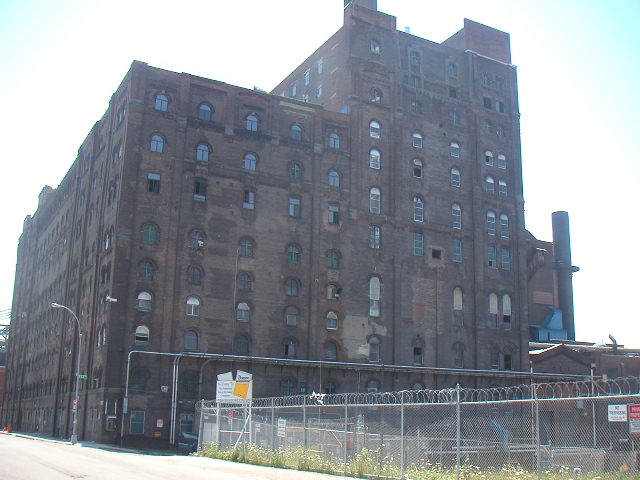 |
|
|
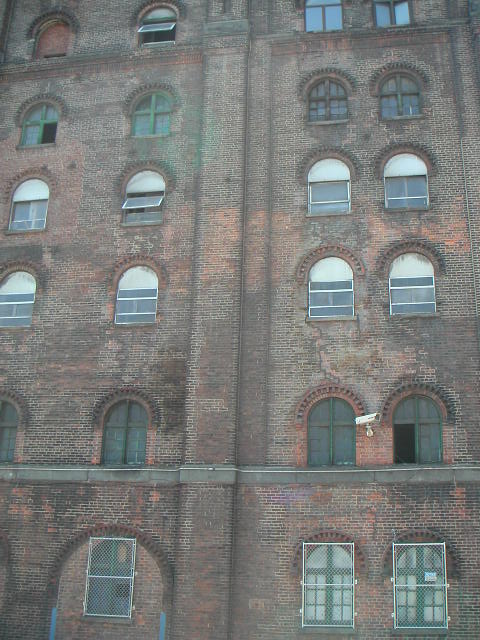 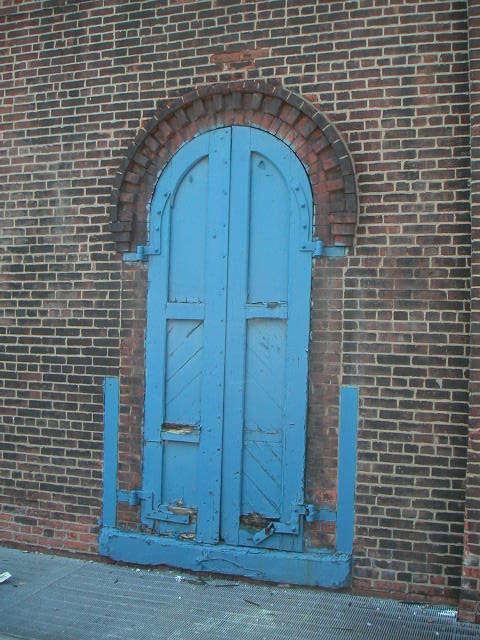 |
|
notes |
Between 2nd and 3rd, and again between 4th and 5th, are bulky, bold Romanesque Revival behemoths. |
|
August 21, 2003
Familiar Domino Sugar Refinery Will Shut Much of Its Operation By DIANE CARDWELL 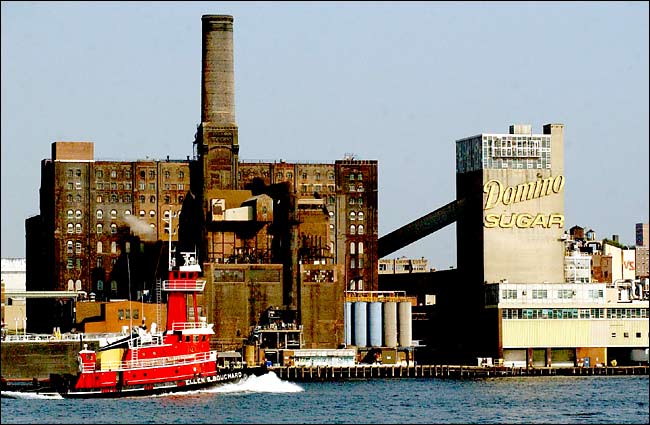 The Domino Sugar refinery, which has dominated part of Brooklyn's waterfront since the 19th century, will retain only its packaging and warehousing operations on the site. The neon Domino Sugar sign looms over the East River like a beacon, visible for miles. Gleaming above the Brooklyn complex where sugar has been refined for more than a century, it has become a symbol of a rapidly fading industrial legacy, a reminder that the city known for high-tech finance and elegant living was built on ships and machinery, brawn and sweat. Although the sign itself may remain illuminated, much of the work it heralds will soon cease. Yesterday at the mammoth brick refinery, a relic of the time when New York led the nation in sugar processing, office staff members and unions representing the other workers were told that sometime before February, the refinery would shut down. Only part of the adjacent packaging operation will continue. About 190 workers stand to lose their jobs, with the remaining 60 or 70 staying on in packaging and warehousing or moving to another of the company's locations. "We can't sell all we can make," said Jack Lay, president and chief executive officer of the American Sugar Refining Company, which acquired the Domino plant on the Williamsburg waterfront in 2001. "The capacity of the refineries exceeds the quantity that we can compete for in the marketplace." The refinery — once the world's largest, according to a company brochure — and its related buildings fill an 11-and-a-half-acre swath along a quarter of a mile of the East River just north of the Williamsburg Bridge. Operating since the 1880's, it was built by the Havemeyer family, which became extremely wealthy as New York picked up the slack left by the Civil War destruction of many Southern refineries. The city at one time processed 60 percent of the nation's sugar. In recent decades, as New York hemorrhaged manufacturing jobs, especially along the waterfront, the plant has been the scene of bitter strikes that drastically cut production. In addition, the use of high-fructose corn syrup instead of sucrose in products like soda and canned fruit severely cut into the demand for sugar, Mr. Lay said. The Domino plant has the capacity to produce about 950 million pounds of sugar a year, he said, but it produced only 400 million pounds last year. The previous owner, Tate & Lyle, had already shed its operations processing raw sugar, instead taking semiprocessed liquid sugar off a barge from the Domino plant in Baltimore and crystallizing it into granules. Now, even that will stop. Mr. Lay said there were no immediate plans for the building itself, a hulking factory that smells on different floors earthy, sweet and sharp, and that has attracted its own set of fans. Last year, for example, members of the Society for Industrial Archaeology toured the building, where stalactites of sugar had formed on some of the pipes. "The short-term impact is not devastation, but it will be very disheartening to people in the neighborhood who have seen jobs leave over two decades," said David Yassky, the city councilman who represents the area. "Long-term, it's part of a trend of the transformation of an industrial waterfront that's going to be used for housing and open space." For example, the city has been pushing forward with a huge proposal to rezone the Williamsburg and Greenpoint waterfront to encourage residential and recreational uses where industry once ruled. Officials drew the plan, however, to preserve the Domino site for manufacturing, and yesterday, Richard Barth, executive director of the Department of City Planning, said that the administration remained "committed to finding an industrial reuse for that site." Still, Mr. Yassky said, the closing is troubling, and underscores the need to protect jobs in places like Sunset Park, which has recently lost hundreds of them to plant closings, and along stretches of the waterfront, where the Port Authority of New York and New Jersey and the Bloomberg administration are considering new uses for mercantile piers. Andrew Alper, president of the city's Economic Development Corporation, said in a statement that the Department of Small Business Services would work with the company to provide job training and placement services to workers slated for layoffs. Several workers outside the complex around lunchtime yesterday, all of whom declined to give their names, said that they had not yet received any official announcement and were working "under a cloud of uncertainty," in the words of one. One man, smoking a cigarette in a yard outside the refinery, seemed fatalistic. "What do you do when you lose your job?" he said between drags, shrugging and chuckling wryly. "Find another one. Life goes on." Copyright 2003 The New York Times Company |
|
|
NY Newsday Sugar Plant Closes After 148 Years By LARRY McSHANE Associated Press Writer January 29, 2004, 4:45 PM EST NEW YORK -- It predated the Brooklyn Bridge and outlasted the Brooklyn Dodgers. The borough's Domino Sugar plant, an East River fixture for 148 years, is closing its refinery operation after Friday's shifts. About 200 bitter employees at the sugar plant will be out of work, many of them people who had spent their entire adult lives working inside the 11-story building with its familiar red neon sign. "This is how we treat the American worker," said Sal Alladeen, president of the union representing the workers. "They're laying off folks who worked in this neighborhood for 30, 40 years." The factory workers forged an unusually strong bond over the years, becoming almost like family. They endured an ugly strike that lasted from June 1999 through February 2001; a despondent 22-year factory worker committed suicide during the walkout. First word of the factory shutdown came in August. But the imminent arrival of the closing day for the 19th-century brick building in the Williamsburg section still delivered a punch in the gut for workers. "It's depressing," said Alladeen. "It's depressing to watch 200 people lose their jobs." The plant was bought in 2001 by the American Sugar Refining Co., which decided to close it. Company officials said the Brooklyn plant was not equipped to compete with its plants in Baltimore, Yonkers, N.Y., and outside New Orleans. American Sugar CEO and president Jack Lay did not return a call for comment Thursday on the closing. When Domino began operating in Brooklyn in 1856, New York was the nation's No. 1 sugar producer. But the sugar industry fell on hard times in the last quarter-century, with 15 refineries closing nationwide since 1980. Sugar companies were losing market share to high-fructose corn syrup and beet sugar. By 2002, the Brooklyn plant still had the capacity to produce 950 million tons of sugar annually _ but it generated only 400 million tons. But Alladeen suggested the closing was more about real estate than sugar. The waterfront property, he said, would be far more valuable if reincarnated as luxury housing in a gentrified neighborhood where lofts can sell for $1 million. Copyright © 2004, The Associated Press The Williamsburg Bridge with the Circle Line boat and Domino Sugar Plant. 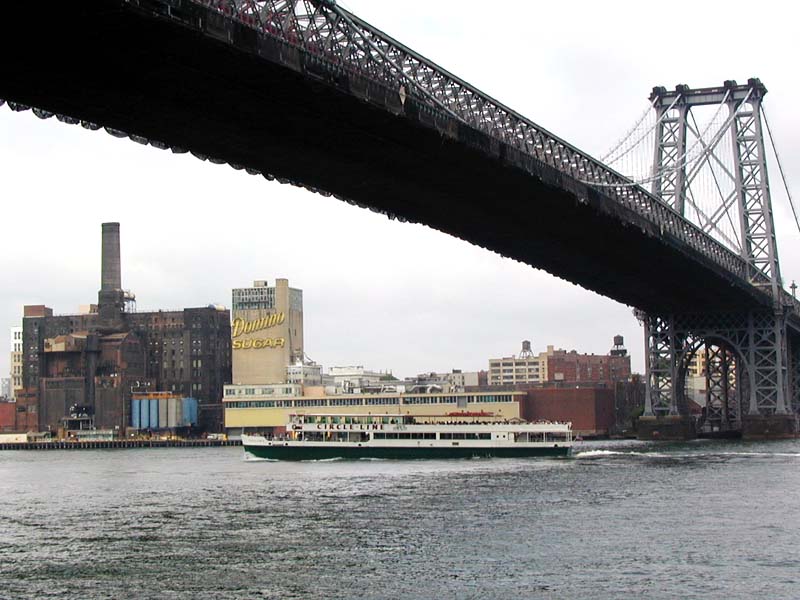
|
|
|
January 31, 2004
The Last Grain Falls at a Sugar Factory By WILLIAM YARDLEY Richard Rednour spent the last week of his 28 years at the Domino Sugar plant in Brooklyn learning how to write a résumé. "Network'' was among the other pieces of advice Mr. Rednour picked up this week at the employment classes the plant had offered to workers who will soon be re-entering the job market. Yesterday, the plant's owner, American Sugar Refining, ended nearly all operations at the Williamsburg refining and packing plant, which has overlooked the East River since the 1880's. Some workers, including Mr. Rednour, 50, a shipping and warehouse foreman, will be looking for work for the first time in decades. "I learned this past week that I'm a dinosaur," Mr. Rednour said yesterday, taking a final drag during his final cigarette break outside the complex of brick and concrete buildings that stretches across more than 11 riverfront acres just north of the Williamsburg Bridge. "Having a job for a long time in one place is not necessarily a good thing. It used to mean I was reliable." More than 220 others who have reliably arrived for work for years will not return on Monday, leaving fewer than two dozen workers to operate the plant at a greatly diminished level - reduced to packaging sugar cubes and filling plastic toy figurines with cinnamon sugar - until it closes permanently later this year. American Sugar, which bought the plant in 2001, announced in August that it would close because of falling demand for cane sugar in an age of beet sugar, high-fructose corn syrup and other competing sweeteners. What will eventually become of the plant is unclear, but speculation among those standing outside it in the cold yesterday morning, shaking hands and saying goodbye, was that it would go the way of the soda factory, the knitting factory, the boot polish factory and so many other factories whose brick shells have been transformed into housing and commercial space to make way for the gentrification rippling through Brooklyn. Williamsburg has changed as the manufacturing plants that once defined it have declined. In Brooklyn as a whole, the average number of manufacturing jobs declined to 33,967 in June 2003 from 88,800 in June 1984. In June 1958, the figure was 222,200, according to data from the state and the United States Department of Labor. Now, retailers on nearby Bedford Avenue trade on that industrial past. One store, Brooklyn Industries, sells clothing and bags, while another, Spoonbill and Sugartown Booksellers, includes an image of the Domino plant in some of its advertising materials. A spokeswoman for the Department of City Planning said the plant was not likely to be turned into housing. Under a proposed rezoning of the Williamsburg and Greenpoint waterfront, the Domino plant site would remain industrial or commercial, possibly with limited retail offerings like a hardware store, or office space. "We really wish to keep the current mix of zoning uses, which are characteristic of the neighborhood," said the spokeswoman, Katie Maccracken. "We have not been approached to change it." Florida Crystals, the Florida agriculture conglomerate that is a co-owner of American Sugar, does not have immediate plans for the site when it closes later this year, said its vice president, Jorge Dominicis. "This wasn't a decision made because we've got some other plan," Mr. Dominicis said in a telephone interview. "We're not that far along.'' He said that while the company was reluctant to lay off workers, a decline in sugar demand had forced it to close the plant, one of two the company owns in the New York area. Some workers may find jobs at the other plant, in Yonkers, he said. The Brooklyn plant endured the boom and decline of Brooklyn's sugar industry - New York was the nation's largest sugar refiner in the late 19th century - and the end has not come easily. Intermittent strikes since the 1980's increased tension between labor and management, closing the plant for 20 months from 1999 to 2001, and yesterday several workers disputed the way American Sugar was interpreting their severance pay plan. Brendan McPartland, the union representative for many of the machinists and mechanics leaving yesterday, said that the plant closing was "a tragedy" and that the union would challenge the company's interpretation of the severance agreement. Jack Lay, president and chief executive of American Sugar, said the dispute would have to be resolved through arbitration. Mr. Lay, 74, a former manager of the plant's refinery, said the distinctive neon Domino Sugar sign, long a landmark for residents of downtown Manhattan, would no longer shine. "I think the sign is pretty much out of business,'' he said. "We would love to have it on for advertising purposes, but it's just become too difficult'' to maintain. Copyright 2004 The New York Times Company
|
|
|
July 1, 2004
Developers Known for Residential Work Buy Domino Sugar Plant on Brooklyn Waterfront By DIANE CARDWELL and ROSALIE R. RADOMSKY Two developers known for residential projects have bought the Domino Sugar refinery in Williamsburg, ending a rich chapter of Brooklyn's industrial waterfront history. C.P.C. Resources, the development arm of the Community Preservation Corporation, a lending consortium of banks and insurance companies best known for financing rehabilitations of older apartments, and Isaac Katan, a Brooklyn developer who has helped gentrify Fourth Avenue in Park Slope, have bought the land and the buildings of the all-but-shuttered plant, said Lloyd Kaplan, a preservation corporation spokesman. The developers would not say how much they paid for the property or what they planned to do with it, instead releasing a statement saying that they "look forward to working with the community and the city as we develop our plans for the site." The Domino plant, with its distinctive neon sign looming over the East River just north of the Williamsburg Bridge, had been operating since the 1880's and was acquired in 2001 by American Sugar Refining. Donald Brainard, vice president for human resources at American Sugar, also declined to discuss the particulars of the sale, but he said the plant's operations were unprofitable. "We announced last August that we would close it ultimately and had no plans for the facility at the time of the initial announcement," he said. American Sugar still has plants in Yonkers, Baltimore and Chalmette, La., but the Brooklyn refinery, once the world's largest, according to a company brochure, had been the most inefficient, Mr. Brainard said, adding that only about 25 employees work there now. "We made a decision to close the operation to increase our efficiency and lower our costs," he said, adding that there had been a partial shutdown of operations in January. "I would guess the rest will close later this year." Although sugar processing ended at the plant last August, news of the sale of the mammoth brick factory and its uncertain future appeared to take neighbors and city officials by surprise. Joseph Markowitz, who had bought the company's office building and parking garage across the street from the refinery about two years ago, said he would like to see it rezoned for residential use, a designation he is seeking for his property. "We have a problem renting to commercial - it's very hard," he said. But City Planning Department officials, who have been pushing forward with an enormous proposal to rezone the Williamsburg and Greenpoint waterfront to encourage residential and recreational uses, had drawn their plan to preserve the Domino site for manufacturing, a move applauded by several officials and labor advocates who would like to see the remnants of the borough's industrial legacy - and its blue-collar jobs - preserved. In August, city officials said they were committed to finding an industrial reuse for the site. "We're not contemplating a rezoning for this site," Regina Myer, the Brooklyn director for the Planning Department, said yesterday. "We're focusing all of our efforts on the rezoning to the north." Copyright 2004 The New York Times Company
|
|
| with thanks to "The AIA Guide to New York", | |